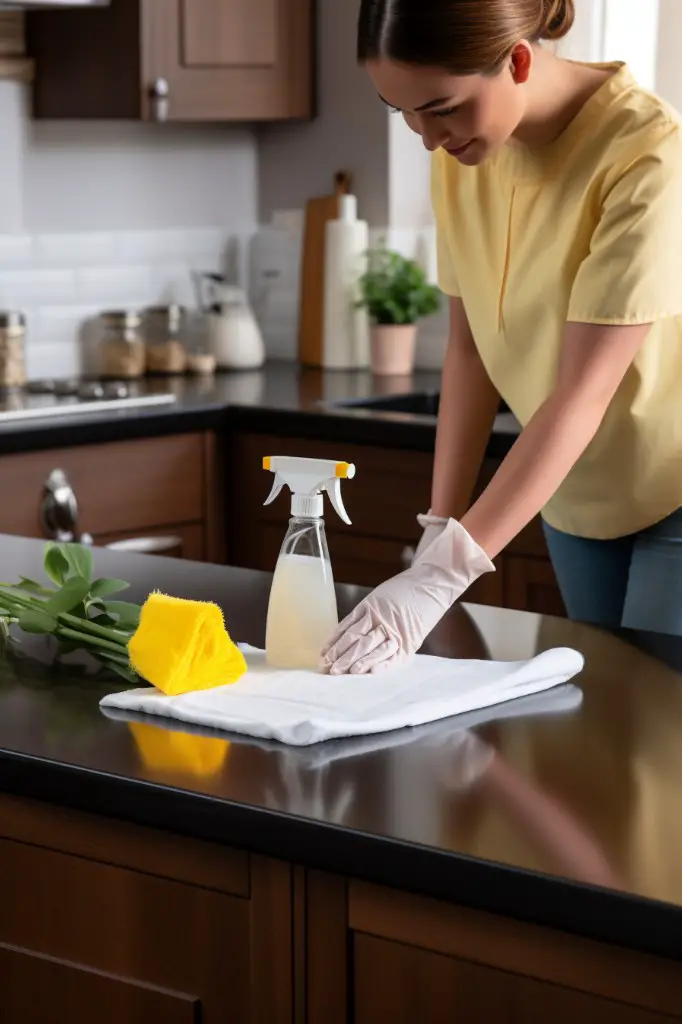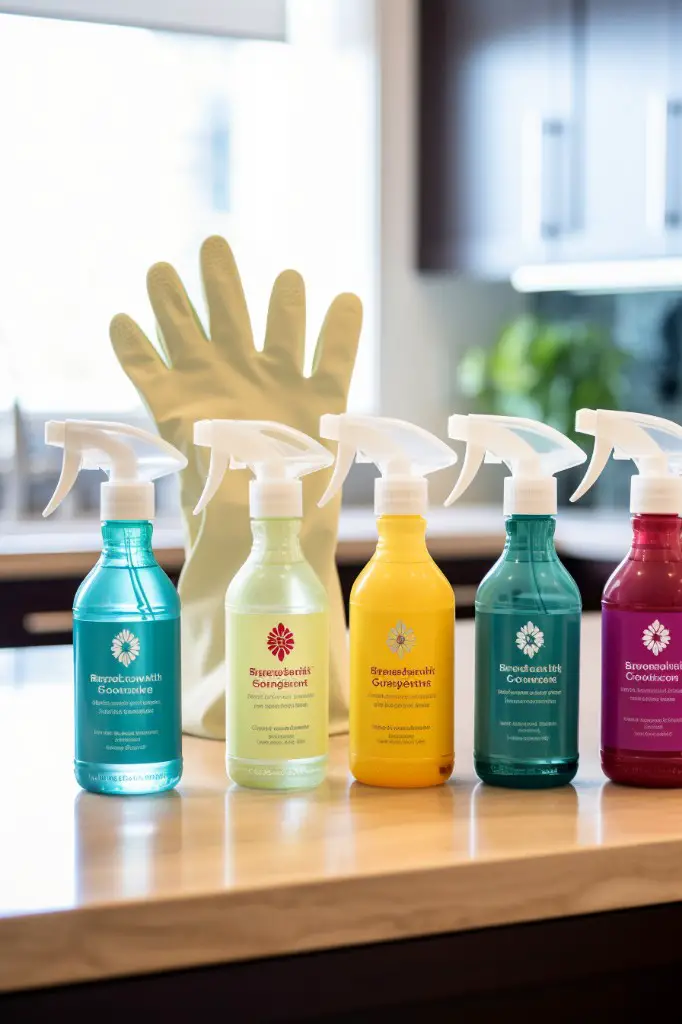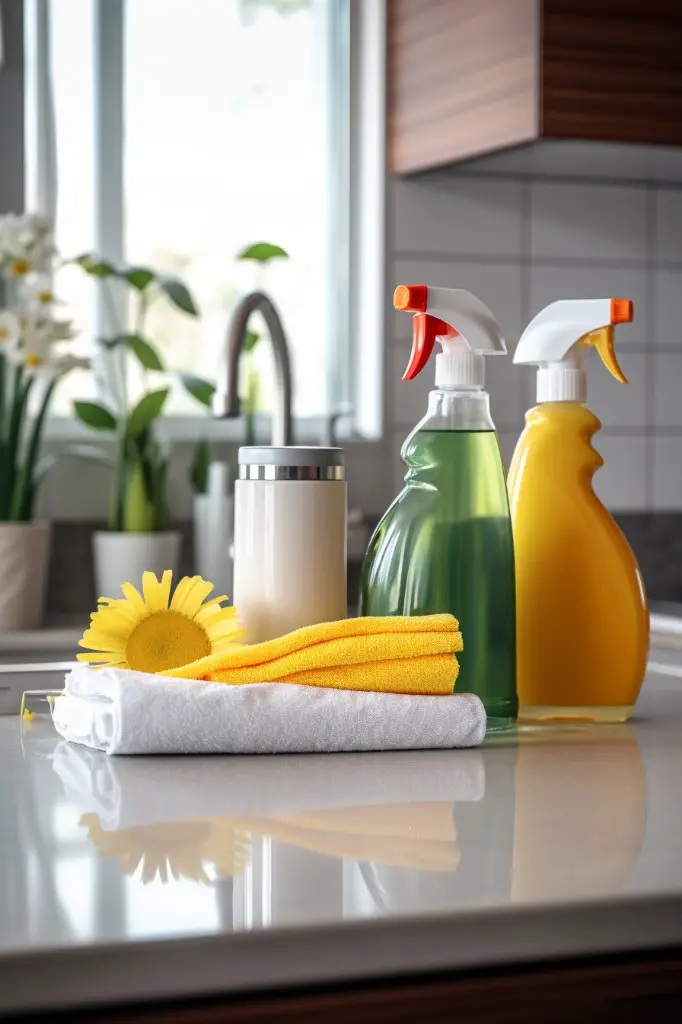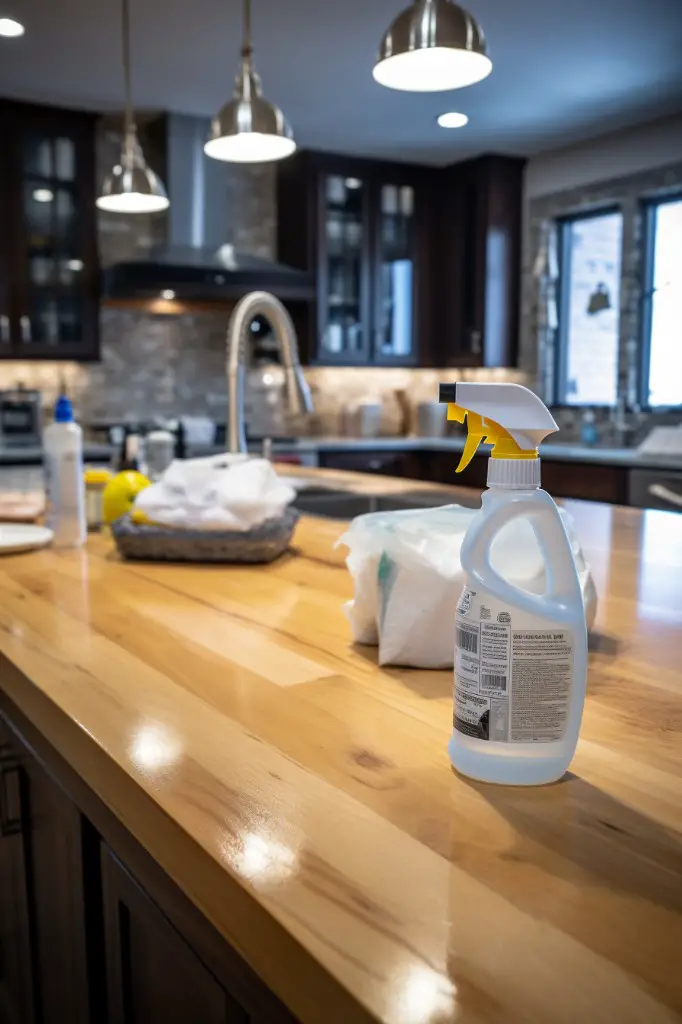Last updated on
Discover the essential steps to effectively disinfect your kitchen countertops, ensuring a clean and healthy space for meal preparation.
The kitchen is the heart of any home, where delicious meals are prepared and memories are made. However, it’s also a breeding ground for bacteria and germs that can cause illnesses.
Keeping your kitchen clean is essential to maintain good health, especially during these times when hygiene is more critical than ever before. In this article, we’ll be discussing how to disinfect one of the most used surfaces in your kitchen – the countertops.
We’ll provide you with simple yet effective ways to keep your countertops germ-free and safe for food preparation. So let’s get started!
What's Inside
Importance of Disinfecting Countertops

The kitchen is a place where we prepare food, and it’s essential to keep the area clean and hygienic. Countertops are one of the most used surfaces in any kitchen, making them a breeding ground for bacteria and germs that can cause illnesses.
Disinfecting your countertops regularly is crucial to maintain good health by preventing cross-contamination from raw foods or other sources.
Moreover, disinfecting your countertops also helps prevent the spread of viruses such as COVID-19. The virus can survive on surfaces for several hours or even days, making it important to disinfect high-touch areas like countertops frequently.
Choosing the Right Disinfectant

Not all cleaning agents are created equal, and some may not be effective against certain types of bacteria or viruses. It’s essential to select a disinfectant that can kill a broad range of germs and pathogens.
One of the most common disinfectants used in households is bleach. Bleach solutions are highly effective at killing bacteria, viruses, and fungi on non-porous surfaces such as countertops.
However, bleach can be harsh on some materials like granite or marble countertops.
If you have natural stone counters in your kitchen, consider using hydrogen peroxide instead of bleach for sanitizing purposes since it won’t damage them over time.
Another option for those who prefer natural products is vinegar-based cleaners that contain acetic acid which has antimicrobial properties but keep in mind they might not work as effectively against all types of germs compared to commercial-grade products.
Gather Required Cleaning Materials

This will ensure that you have everything on hand and won’t need to interrupt the process midway. The good news is that most of these items are readily available in your home or local grocery store.
To start with, get a pair of gloves to protect your hands from harsh chemicals and bacteria. You’ll also need a clean cloth or sponge for wiping down surfaces after disinfection.
Next, choose an appropriate disinfectant based on what works best for your countertop material and personal preferences. Commonly used options include bleach solution (1 tablespoon bleach per gallon of water), hydrogen peroxide (3% concentration), vinegar solution (equal parts water and vinegar), or commercial cleaners labeled as “disinfectants.”.
Lastly, keep a trash bag nearby so that you can dispose of any debris while cleaning without leaving the area unattended.
Preparing the Surface for Disinfection

This step ensures that the disinfectant can penetrate and eliminate all germs and bacteria effectively. Start by clearing away any clutter or debris on the countertop surface, including small appliances, utensils, or food items.
Next, use a clean cloth or paper towel to wipe down the entire countertop with warm soapy water. Be sure to remove any visible dirt or grime from corners and edges of your countertops.
After cleaning with soap and water solution rinse thoroughly using clean water then dry completely using a fresh towel before applying any disinfectant solution.
Clear Away Clutter and Debris
This step is crucial as it allows you to access all areas of the countertop surface easily. Start by removing any items that are not supposed to be on the counter, such as utensils, appliances or food containers.
Next, wipe down the surface with a damp cloth or sponge to remove crumbs and other loose particles. Pay attention to corners and edges where dirt can accumulate over time.
If there are stubborn stains or spills on your countertop surface that won’t come off with water alone, use a mild detergent solution before proceeding with disinfection methods.
Using Soap and Water
This method is especially useful for surfaces that come into contact with food, as it eliminates germs without leaving any harmful residue.
To use this method, start by clearing away any debris or clutter from the countertop surface. Next, mix a few drops of dish soap with warm water in a spray bottle or bucket.
Spray or apply the solution onto the countertop surface and scrub gently using a clean cloth or sponge.
Be sure to pay extra attention to areas where food particles may have accumulated such as around sink edges, stove tops, and other high traffic areas on your counters. Rinse thoroughly with clean water after cleaning.
Soap works by breaking down grease molecules which can harbor bacteria while also lifting dirt off surfaces making them easier to wipe away during rinsing. While this method may not be suitable for all types of countertops like granite since they are porous materials that could absorb moisture leading to discoloration over time; it’s an excellent option for non-porous surfaces like laminate countertops commonly found in many homes today.
Applying Bleach Solution
To make a bleach solution, mix one tablespoon of bleach with one gallon of water. It’s essential to wear gloves when handling bleach as it can irritate the skin.
Before applying the solution, clean your countertop with soap and water to remove any dirt or debris. Then apply the bleach solution using a spray bottle or cloth, making sure to cover all areas thoroughly.
Leave the solution on for at least five minutes before wiping it away with a damp cloth. Rinse thoroughly with water afterward and dry completely.
It’s important not to use too much bleach as this can damage some surfaces such as granite or marble countertops. Always follow manufacturer instructions for dilution ratios and application methods specific to your countertop material.
Disinfecting With Hydrogen Peroxide
It’s an effective alternative to bleach, especially for those who prefer natural cleaning solutions. Hydrogen peroxide works by breaking down into water and oxygen, leaving no harmful residue behind.
To use hydrogen peroxide as a disinfectant, start by wiping the surface with soap and water to remove any dirt or debris. Then pour some hydrogen peroxide onto the countertop or spray it directly on the surface.
Allow it to sit for several minutes before wiping away with a clean cloth or paper towel. For tough stains or stubborn grime buildup, you may need to repeat this process multiple times until your countertop is completely disinfected.
It’s important not to mix hydrogen peroxide with other cleaning products such as vinegar or bleach since this can create dangerous chemical reactions that release toxic fumes.
Vinegar As a Natural Disinfectant
It’s an excellent alternative to chemical-based cleaners, especially if you’re looking for a more eco-friendly option. Vinegar contains acetic acid, which helps kill bacteria and viruses on contact.
To use vinegar as a disinfectant, mix equal parts of water and white vinegar in a spray bottle. Spray the solution onto your countertops and let it sit for at least 10 minutes before wiping it away with a clean cloth or paper towel.
While vinegar is effective against most germs, it may not be suitable for all types of surfaces. Avoid using vinegar on natural stone countertops like marble or granite since the acid can etch the surface over time.
Using vinegar as an all-natural disinfectant can be an effective way to keep your kitchen countertops germ-free without exposing yourself or your family members to harsh chemicals found in commercial cleaning products.
Utilizing Commercial Disinfectants
These products come in various forms, including sprays, wipes, and solutions. When selecting a commercial disinfectant for your kitchen countertops, it’s essential to choose one that is approved by the Environmental Protection Agency (EPA) as effective against viruses and bacteria.
Before using any commercial disinfectant on your countertop surface, read the label carefully to ensure it’s safe for use on that particular material. Some surfaces may be sensitive or porous and require specific cleaning agents.
When applying a commercial disinfectant solution or spray onto your countertop surface, follow the manufacturer’s instructions closely regarding application time before wiping away with a clean cloth or paper towel.
It is important not to overuse these products as they can leave behind harmful residues if not rinsed off correctly after use. Always rinse thoroughly with water after using any chemical-based product on food preparation surfaces like countertops.
Wiping Techniques for Effective Disinfection
Wiping is a crucial step in ensuring that all germs and bacteria are eliminated from the surface. Here are some tips on how to wipe effectively:
1. Use disposable paper towels or clean cloths: Avoid using sponges as they can harbor bacteria.
2. Start from one end of the countertop and work towards the other end: This ensures that you don’t miss any spots.
3. Apply pressure while wiping: Applying pressure helps remove dirt, grime, and germs more effectively.
4. Change cleaning cloths frequently: Using dirty rags will only spread germs around instead of eliminating them.
5. Allow surfaces to air dry naturally after wiping with a disinfectant solution; this gives time for any remaining pathogens to be destroyed by chemicals in the cleaner.
How Often to Disinfect Countertops
The frequency of disinfection depends on how often you use the countertop and what type of food you prepare. If you cook frequently or have a large family, it’s best to disinfect daily or even multiple times a day if necessary.
However, if your kitchen is not used as often or only for light meal preparation, then once every few days may be sufficient. It’s also important to note that certain areas of the countertop may require more frequent cleaning than others.
For instance, cutting boards should be disinfected after each use since they come into direct contact with raw meat and other foods that can harbor harmful bacteria. Any spills should be cleaned up immediately using soap and water before applying a disinfectant solution.
Handling Food Safely On Countertops
Even with clean and disinfected countertops, there are still some precautions you need to take when handling food on them. Raw meat, poultry, fish or eggs can contain harmful bacteria that can cause illness if not handled properly.
To avoid cross-contamination of germs from raw foods onto your kitchen surfaces and other cooked foods:
- Use separate cutting boards for raw meats and vegetables.
- Wash your hands thoroughly before preparing any food.
- Avoid placing cooked or ready-to-eat foods on the same surface as raw meats.
- Clean utensils between uses with hot soapy water or in the dishwasher.
By following these simple steps while handling food on your countertops will help prevent contamination of germs from spreading onto other surfaces in your kitchen.
Safely Store Raw Food
When storing raw meat, poultry, or fish in your kitchen, it’s essential to keep them separate from other foods. This will help avoid cross-contamination and reduce the risk of foodborne illnesses.
To safely store raw food:
- Keep them in sealed containers or plastic bags.
- Place them on a plate or tray at the bottom shelf of your refrigerator.
- Use a thermometer to ensure that your fridge temperature stays below 40°F (4°C).
- Freeze meats if you’re not planning on using them within two days.
By following these simple steps, you can minimize health risks associated with consuming contaminated foods. Remember always to wash hands thoroughly before handling any type of raw meat and disinfect countertops after preparing such meals.
Cleaning and Disinfecting Cutting Boards
To ensure that your cutting board is free from germs, it’s important to clean and disinfect it after every use.
Start by washing the cutting board with hot soapy water, making sure to scrub all surfaces thoroughly. Rinse the board with hot water and dry it completely using a clean towel or paper towels.
To disinfect the cutting board, you can use a solution of one tablespoon of unscented bleach per gallon of water. Apply this solution to the surface of your cutting board using a cloth or sponge and let it sit for several minutes before rinsing off with hot water.
Another natural way to disinfect your cutting boards is by applying white vinegar directly onto its surface. Let this sit for 5-10 minutes before wiping away excess liquid with a damp cloth or sponge.
It’s important always to keep separate chopping boards for raw meat/poultry/fish/seafood products than those used for fruits/vegetables/bread/dairy products as cross-contamination could occur otherwise leading towards foodborne illnesses.
Addressing Spills and Contamination
If you spill raw meat juices or other potentially hazardous substances on your countertops, clean them up immediately with soap and water. Use a paper towel or cloth that can be washed at high temperatures to avoid cross-contamination.
If you have porous countertops like granite or marble, spills can seep into the surface and cause stains. In such cases, use a disinfectant specifically designed for these surfaces after cleaning up the spill with soap and water.
It’s also essential to sanitize your countertops regularly if they come into contact with food items that carry harmful bacteria like salmonella or E.coli. This is especially important if you have young children who may touch surfaces frequently while playing in the kitchen.
Maintaining Grout and Tile Countertops
They require proper maintenance to keep them looking clean and new. The grout between the tiles is porous, which means it can easily absorb dirt, stains or bacteria if not cleaned regularly.
To maintain your grout and tile countertops effectively:
- Start by wiping down the surface with warm soapy water using a soft cloth or sponge.
- Use an old toothbrush dipped in baking soda paste to scrub away any stubborn stains on the grouts.
- Rinse thoroughly with clean water.
- Dry off excess moisture using a dry towel.
It’s essential to avoid harsh chemicals that can damage your tiles’ finish when cleaning your countertop surfaces as this may cause discoloration over time.
Disinfecting Porous Surfaces
These materials have tiny pores that can harbor bacteria and viruses even after cleaning. To effectively disinfect porous surfaces, you need a solution that can penetrate the pores without damaging the material.
One of the best ways to disinfect porous surfaces is by using hydrogen peroxide or vinegar solutions. Both are natural cleaners that are safe for most types of countertops and effective in killing germs.
To use hydrogen peroxide on your countertop surface:
- Mix equal parts water with 3% hydrogen peroxide.
- Apply this solution onto your countertop surface.
- Let it sit for at least five minutes before wiping away with a clean cloth.
For vinegar-based solutions:
- Mix equal parts water with white distilled vinegar
- Apply this mixture onto your countertop surface
- Let it sit for at least ten minutes before wiping away
It’s important to note that some porous materials may require specialized care when being disinfected; always check manufacturer instructions or consult an expert if unsure about how best to proceed.
Precautions When Using Chemical Disinfectants
It’s essential to take precautions when handling these products as they can be harmful if not used correctly.
Firstly, always read the label instructions carefully before use. Follow the recommended dilution ratios and application methods for each product you use.
Never mix different types of cleaning solutions together as this could create dangerous fumes or reactions.
Secondly, wear protective gloves while handling chemical disinfectants to avoid skin irritation or burns. Ensure that there is adequate ventilation in your kitchen area by opening windows or turning on exhaust fans during cleaning.
Lastly, keep all cleaning products out of reach from children and pets at all times. Store them in a secure location away from food items and other household chemicals.
Ensuring a Germ-Free Kitchen Environment
Regular cleaning and disinfecting of surfaces such as countertops, cutting boards, and utensils are crucial in preventing the spread of harmful bacteria. It’s important to handle food safely by washing hands before handling food items and storing raw meat separately from other foods.
Another way to promote a healthy kitchen environment is by regularly sanitizing high-touch areas such as doorknobs, light switches, refrigerator handles or buttons on appliances like microwaves or ovens. These areas can harbor germs that can easily be transferred onto your hands when touched.
Furthermore keeping your kitchen well-ventilated helps reduce moisture levels which prevent mold growth that could cause respiratory problems for you and your family members.
By following these simple steps consistently over time will help create an overall healthier living space for everyone in the household while also ensuring delicious meals are prepared with minimal risk of contamination!
FAQ
What is the best way to disinfect kitchen surfaces?
The best way to disinfect kitchen surfaces is to first clean them with soap and water, then apply an EPA-registered household disinfectant according to label instructions or use a diluted household bleach solution if suitable for the surface.
Does vinegar disinfect kitchen counters?
Yes, vinegar can disinfect kitchen counters when used in a 1:1 ratio with water as a food-safe alternative to bleach.
What is the most sanitary way to clean counters?
The most sanitary way to clean counters is by applying dish soap to a damp cloth with warm water, wiping down the counter, rinsing the cloth, and then using the rewet cloth to remove soap suds from the countertop.
Which types of disinfectants are most effective for eliminating germs on kitchen countertops?
Types of disinfectants most effective for eliminating germs on kitchen countertops include bleach, alcohol-based solutions, and hydrogen peroxide.
How often should one disinfect kitchen countertops to maintain a sanitary environment?
One should disinfect kitchen countertops daily to maintain a sanitary environment.
Are there any natural alternatives to commercial disinfectants for cleaning kitchen counters effectively?
Natural alternatives to commercial disinfectants for cleaning kitchen counters effectively include using vinegar, lemon juice, and baking soda.




